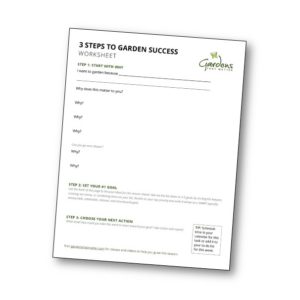3 Steps to Garden Success (Even When Life is Crazy)
Do you have big ideas for your yard? Dreams about what you want to create and grow for your family? In this video and the post below, I share three steps you can take today that will lead you down that path to garden success in the season ahead. These tips work even when life is crazy, especially when life is crazy.
After more than 15 years of gardening, I know how it feels to go from the excitement of a new season—the possibilities, the seed catalogs, my big box of seed packets—to feelings of overwhelm or disappointment when things just didn’t turn out the way I’d envisioned them.
Maybe 25 tomato plants was too many for our family…
We got the garlic in late and it just didn’t make…
Things came up with the kids and we didn’t get the garden weeded at a key time aaaaand the weeds got ahead of us…
Those feelings of overwhelm or disappointment can be really frustrating as a gardener. That’s why I want to share this three-step process. It comes from lesson one of Start Your First Garden, our online class designed just for beginners. But whether this is your very first garden or your fortieth garden (congratulations!), this process is one you can use to help achieve that vision that you have for your yard and garden.
At the end, I’m going to share my best tactical tip. It’s a practice that helps me keep moving towards my vision and what we want to do in our own garden and in our own life.
Let’s jump in!
Step One: Start with Why
Download this printable worksheet or grab a piece of paper and a pen. At the top, write “I want to garden because [fill in the blank with your why].”
For example, I want to garden because I want to grow blueberries.
But don’t stop there. Ask yourself Why? again. Why does that first reason matter to you?
Why do I want to grow blueberries? Because blueberries are perennials, they’re awesome, and my kids love to eat them.
And then you’re going to channel your inner child and ask yourself: Why?…Why?…Why?… Ask it 5, 6, 7 times.
You are going to get down to your core purpose, the cause or the passion that makes you to want to grow and create in your yard. What makes you want to start a new garden or expand a current one? What is your motivation for rolling up your sleeves and getting to work?
Why does does it matter that my kids love blueberries? Well, I want my kids to enjoy spending time in the garden. Since I know they love blueberries, if I plant them, I know they’ll be out there.
And why does that matter? If they’re in the garden, they’re more likely more likely to eat the food that they help grow.
Why does that matter? I want them to eat fresh, healthy food.
You can see how you can get deeper and deeper.
Why? When they eat fresh, healthy food, they’ll be healthy and they’ll develop healthy habits as they grow up.
You may have a why that’s similar or very different. It might be related to saving money and resources, spending time with your family or in nature, have some nice alone time, eating healthy yourself, or even having the best looking yard in the neighborhood.
Whatever your why is, dig in to understand it. Getting clear about your why helps you in a couple of ways:
- We all have a limited amount of time, money, and energy to spend in the garden. Knowing your why helps you spend those resources wisely.
- Your why also serves as a guide when you make decisions about your garden.
For example, you have the choice of buying the standard green cabbage, the frilly cabbage, or the purple cabbage. If your why is related to saving money and food production, you’re probably going to go with the old standard. It’s the one you know does well in your soil. If your why is related to experiences (like getting your kids curious about nature) or beauty, you’d probably go for frilly or purple. Or maybe you decide to grow all three! When your why is the guide. the decision is going to be a good one.
Step Two: Set Your #1 Goal for the Season
What is the outcome you want? If nothing else happened in your garden, what would be the one thing that would make you happy about how the season went?
On your paper, brainstorm all the things you want to do. I’ll bet you have more than one goal or project for your garden. I usually have a few too many myself. 😉
Once you have the list down on paper, narrow your list. Circle the keepers, cross out the extras, or combine items on your list until you’ve got three to five goals for the season.
Next, pick one goal to be your priority. Your #1 goal. When you’re clear about that priority, it gives you focus and momentum.
Be sure you write it down as a SMART goal. SMART stands for specific, measurable, attainable, relevant and time-bound.
When a goal is specific and measurable, you’ll be able to say at the end of the season, “Did I hit my goal? If not, how close did I get?”
If you just set a goal like “I want to create a beautiful garden!” it is more of an aspiration. You had a few beautiful plants, but the whole garden didn’t come together as you wanted. Did you hit your goal or not?
Be more specific and put a measurable with it.
For example, my #1 goal for the coming year is to establish three beds of perennials (plants that come back year after year) designed around blueberries, passion vine, and hardy kiwi. We have some of these plants, and I want to add even more. We’ll shape beds, put in structures, and add other plants that work well with these three stars. At the end of this season, I’ll be able to look and see if I have hit this goal. It’s specific and measurable.
Attainable means setting a goal that is possible. You don’t want to set such a big goal that it becomes discouraging. Set a goal that is possible. Now, you may have to stretch and work really hard to reach it.
Relevant simply means is this goal related to the area you’re working on. In this case, we’re talking about gardening and setting the garden goal. Good to go there.
Finally, time-bound. Our gardens have natural bounds for time we call seasons: spring, summer, fall, and winter. You could set a goal based on a season, or you could use the whole growing season, a.k.a. the whole year, and set your goal based on that time frame.
Step Three: Choose Your Next Action
What step could you take today or this week to help move you towards your #1 goal?
With your goal in mind, identify the very next step. Sometimes, this will be a small step, and other times, you’ll be able to map out a few steps to take together.
For example, I need one more hardy kiwi plant and so I’ll research where I can buy one locally.
Next, I’ll look up which varieties of blueberries bloom the latest so that I can choose new plants that extend our harvest.
Your next action will start with a verb: research, order, measure, build, prepare, plant, water, weed, trim, harvest, and so on.
When you accomplish the task, choose your next action and repeat!
Now, how do you take action in a way that lets you make progress toward your goal week in and week out?
TIP: Schedule time in your calendar for this task or add it to your to do list for this week.
However you manage your list of things you need to do this week, be sure you include your garden’s next action. This might look like blocking time on your calendar. A little garden date for yourself! Decide on a time to take the next action and move toward your goal.
This will help you make time for the garden and the goal and the why that you’ve decided matter in your own life.
We’re here to help you grow your garden, and I’d love to hear about what you have planned. What’s your number one goal? And what challenge might slow you down or keep you from achieving that goal?




